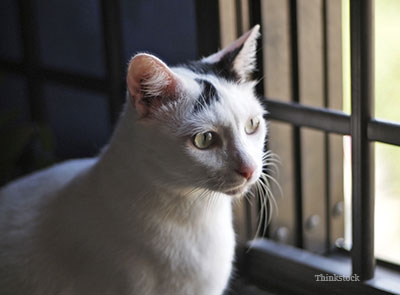
Glomerular disease (chronic kidney disease) is relatively uncommon in cats. It affects both purebreds and mixed-breed kitties, and can be an inherited disorder called amyloidosis in Abyssinians, Orientals and Siamese cats1.
Does glomerular disease have other names?
Veterinarians use a number of different terms interchangeably when describing “glomerular disease.” I’ll warn you, in advance, none of them are easy to pronounce:
- Glomerulopathy
- Glomerulonephropathy
- Glomerulonephritis
- Protein losing nephropathy
What are glomeruli and why should you care?
To understand glomerular disease, it’s important to first understand glomeruli. Each kidney contains millions of glomeruli; these are microscopic filtration units that interface with the blood vessels that supply the kidneys. I like to think of the glomeruli as a tiny sieve or colander because the size of glomerularpores dictate which substances within the blood are allowed to enter the fluid that ultimately becomes urine. Normal glomeruli do not allow larger protein molecules, such as albumin, to pass into the urine.
Glomeruli damage causing glomerular disease
Glomeruli damage is what leads to glomerular disease. The most common means by which glomeruli are damaged include:
- Inflammation, particularly that which is immune mediated (autoimmune) in nature
- A form of scarring referred to as glomerulosclerosis
- Persistent high pressure blood flow to the kidneys (elevated blood pressure)
- A protein problem called amyloidosis.
When glomeruli are damaged, they become “leakier,” thus allowing larger protein molecules to filter into the urine. This leads to a condition called proteinuria, which means too much protein in the urine.
What problems are associated with glomerular disease?
Glomerular damage, particularly when left untreated, hastens the progression of chronic kidney disease.
Glomerular damage can arise as a primary disease process, or it can occur secondary to another, underlying disease—including:
- Feline leukemia virus
- Feline immunodeficiency virus (FIV)
- Feline infectious peritonitis (FIP)
- Hyperthyroidism
- Cholangiohepatitis (liver inflammation)
- Pancreatitis
- Infectious diseases (bacterial, fungal, tick-borne)
- Cancer
- Immune mediated (autoimmune) diseases
Symptoms of glomerular disease
In and of itself, protein loss in the urine does not cause any symptoms. This is why some cats with glomerular disease, particularly early on, appear completely normal. When symptoms do arise, they are usually related to one or more of the following:
- Underlying disease causing the glomerular damage (see the list above)
- Chronic kidney disease
- Complications associated with glomerular damage (high blood pressure, decreased protein in the bloodstream, blood clot formation)
Commonly observed symptoms in cats with chronic kidney disease include:
- Vomiting
- Loss of appetite
- Lethargy
- Weakness
- Increased thirst and urine output
- Weight loss
- Halitosis (bad breath)
Testing for glomerular disease
There are several laboratory tests that can be used to assess protein in the urine. The first test will probably be a urinalysis.
Urine dipsticks provide “semi-quantitative results.” This means that a positive test result gives only a rough idea of how much protein is in the urine. It’s critical to always start with a complete urinalysis because the urine quality and presence of any inflammatory cells or blood can influence protein levels.
The urinalysis may be falsely positive for protein, Additionally, it is not always sensitive enough to detect the very earliest stages of glomerular damage. For these reasons, your veterinarian may discuss additional testing.
Diagnosing glomerular disease
If a cat demonstrates persistent proteinuria (too much protein in the urine), repeatable on multiple tests over the course of a few weeks, a battery of tests is typically recommended to rule out non-glomerular causes such as urinary tract inflammation, infection, stones or bleeding. This testing typically includes the following:
- Complete blood cell count (CBC)
- Blood chemistry profile
- Urinalysis
- Urine culture
- Abdominal ultrasound or x-rays
Other tests may be recommended to rule out infectious processes, cancer and other diseases that can cause secondary glomerular damage or worsen it. Diagnostics may include:
- Thyroid level measurement

- Chest x-rays
- Abdominal ultrasound
- Specific screening tests for infectious diseases
- Measurement of blood pressure
A clear-cut diagnosis of glomerular disease requires a kidney biopsy. This can be accomplished via surgery, laparoscopy or with ultrasound guidance. Whichever methodology is used, collection of a kidney biopsy has the potential to cause significant complications. Thoughtful discussion with a veterinarian about risks and benefits should always precede a kidney biopsy.
Complications commonly caused by glomerular disease
As if glomerular disease isn’t enough to worry about, it is capable of causing a number of serious secondary issues including:
- Hypertension (high blood pressure): Can cause damage in heart, kidneys, brain and/or retinas and also promotes proteinuria
- Hypercoagulability (an increased likelihood to form blood clots): Thromboembolism (blood clot) formation can occur within any organ
- Chronic kidney disease
Treatment of glomerular disease
There are four primary goals when treating feline glomerular disease. How they are implemented will depend, in part, on the cat’s kidney function and degree of proteinuria.
- Identify and eliminate the underlying cause of the glomerular damage: Doing so may resolve the proteinuria altogether (the best outcome possible). For example, successful treatment of hyperthyroidism may eliminate the associated glomerular damage. Unfortunately, in many cases, the underlying cause of the glomerular disease cannot be identified or successfully eliminated.
- Attempt to lessen the degree of proteinuria: Doing so is the best bet for slowing the progression of kidney damage and other complications associated with glomerular disease. The mainstays of such therapy include diet changes, supplements and medication.
- Treatment of glomerular disease complications: Examples of such treatments include administration of medications to control high blood pressure, anticoagulant therapy to help prevent blood clot formation, and daily subcutaneous fluids to manage dehydration associated with chronic kidney disease.
- Follow up monitoring: Once the diagnosis of glomerular disease is made and treatment is instituted, there will be a need for ongoing monitoring. The results of such monitoring will direct how the cat’s therapy should be adjusted.
The treatment of glomerular disease can be challenging, and the more experience a veterinarian has with this disease, the better. For this reason, when a glomerular disorder is suspected or has been diagnosed in your cat, I strongly encourage consulting with a veterinarian who specializes in small animal internal medicine, ask your veterinarian for a recommendation.
Prognosis of glomerular disease
The earlier glomerular disease is detected and managed, the greater the likelihood of avoiding a negative outcome. Left unchecked, glomerular disease in cats is known to increase the severity and progression of kidney disease.
Feline glomerular disease is usually associated with chronic kidney disease that may progress very slowly, very quickly, or anything in between. Some cats live for several years with glomerular disease and kidney disease. The likelihood of such an outcome is far greater with appropriate treatment and monitoring.
Click here to learn more about chronic kidney disease in cats.
Questions for your veterinarian
- Have causes of proteinuria other than glomerular disease been ruled out?
- How severe is the protein loss?
- Does my cat have advanced chronic kidney disease?
- Have tests been performed to rule out an underlying cause of the glomerular disease?
- What are the risks and benefits of a kidney biopsy?
- What are the treatment options?
- Should my cat’s diet be modified?
- How frequently should my cat be reevaluated?
If you have any questions or concerns, you should always visit or call your veterinarian -- they are your best resource to ensure the health and well-being of your pets.
Resources:

